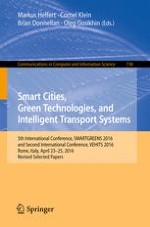2017 | Buch
Smart Cities, Green Technologies, and Intelligent Transport Systems
5th International Conference, SMARTGREENS 2016, and Second International Conference, VEHITS 2016, Rome, Italy, April 23-25, 2016, Revised Selected Papers
herausgegeben von: Markus Helfert, Cornel Klein, Brian Donnellan, Oleg Gusikhin
Verlag: Springer International Publishing
Buchreihe : Communications in Computer and Information Science
